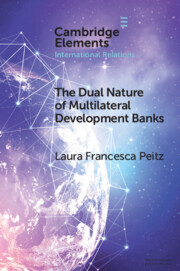Element contents
The Dual Nature of Multilateral Development Banks
Published online by Cambridge University Press: 20 March 2023
Summary
Keywords
- Type
- Element
- Information
- Online ISBN: 9781009392297Publisher: Cambridge University PressPrint publication: 06 April 2023
References
- 10
- Cited by

